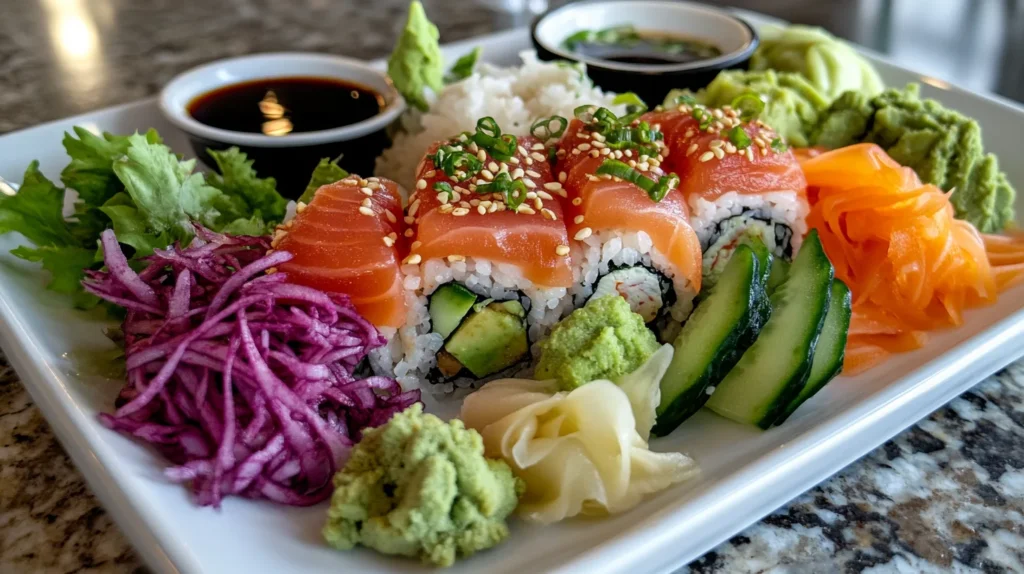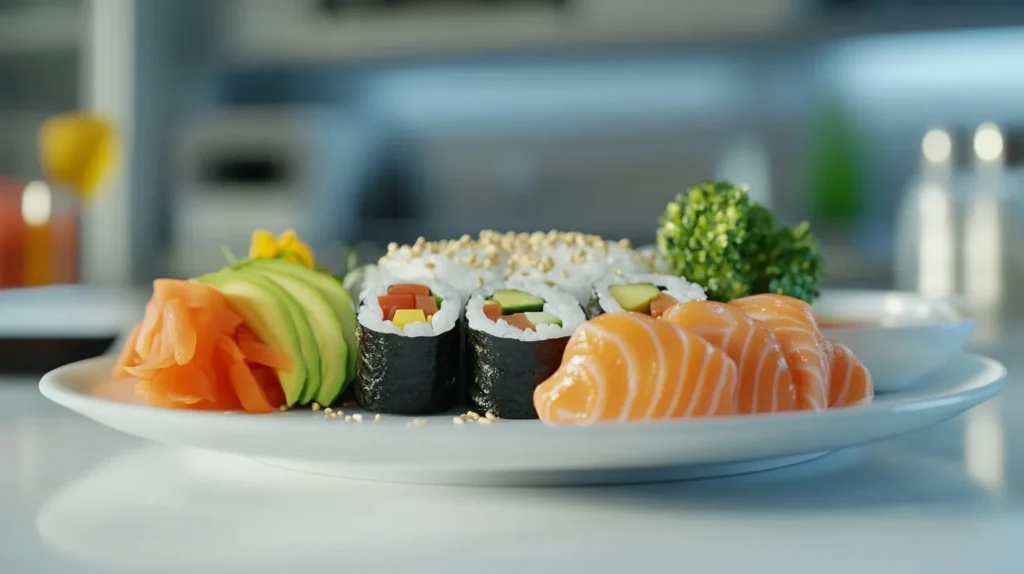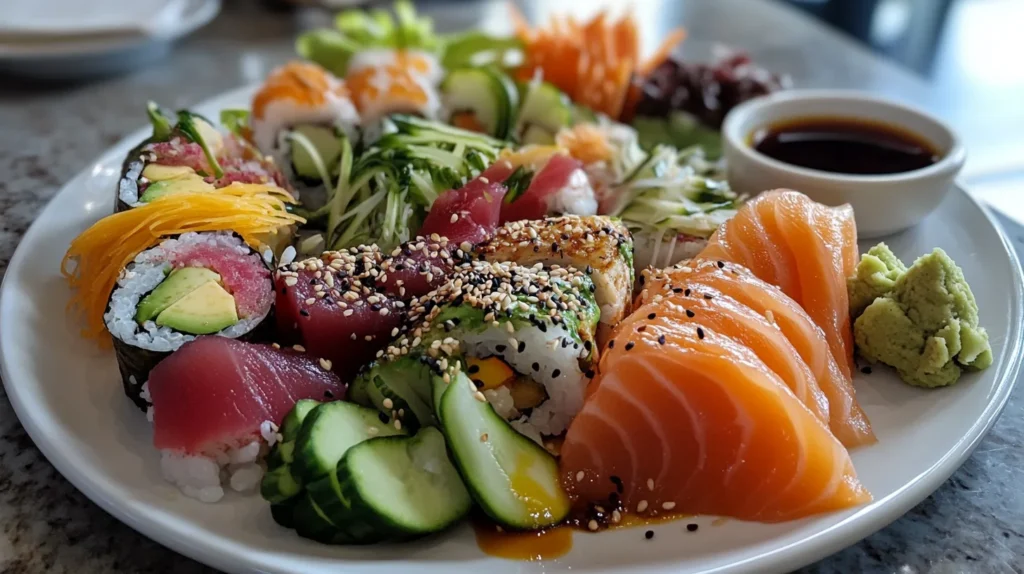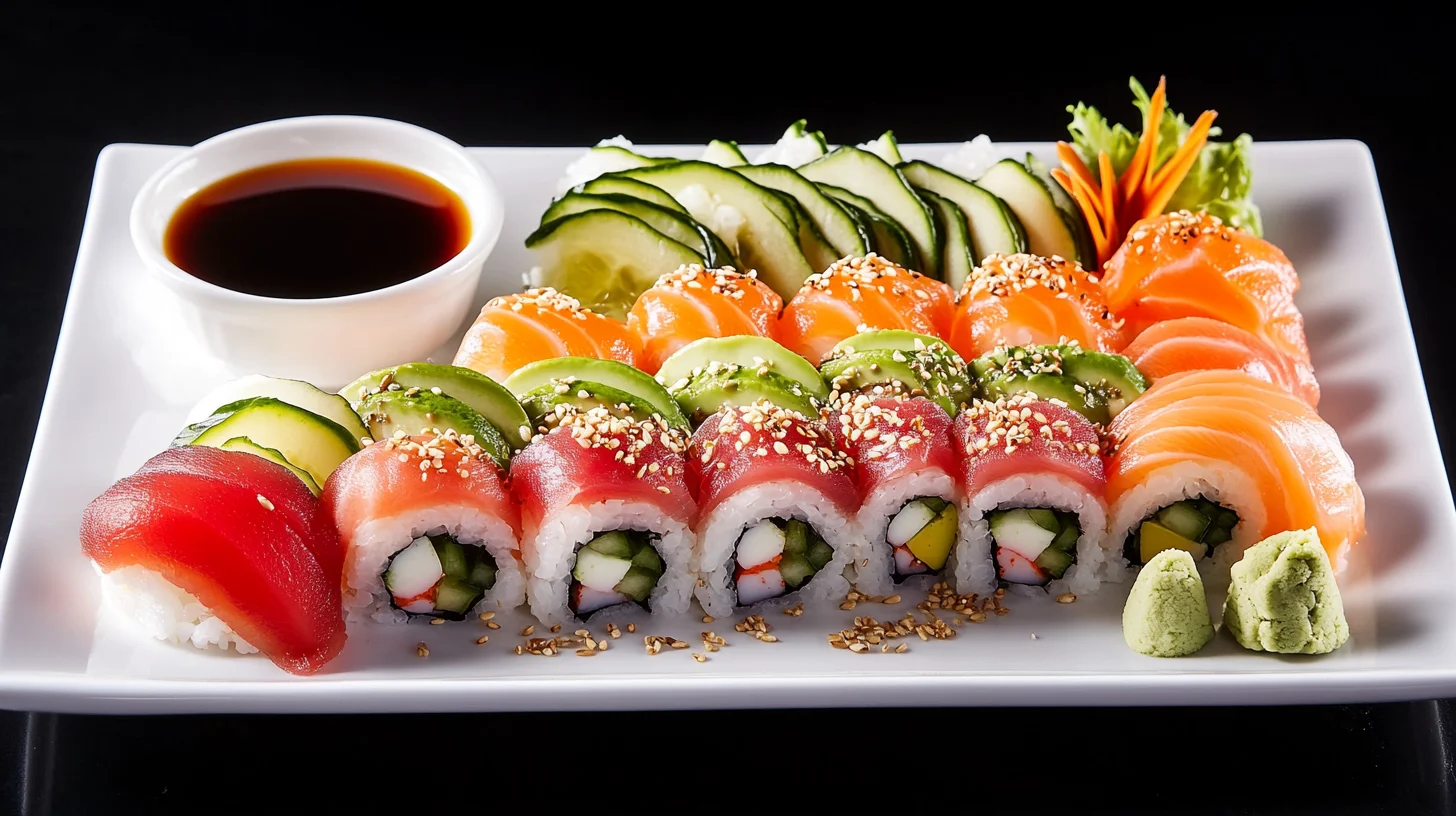Low Sodium Sushi Meal Recipes – Healthy & Flavorful Ideas
When it comes to enjoying sushi, many people worry about the sodium content typically found in traditional recipes. This concern has led to the creation of Low Sodium Sushi Meal Recipes that cater to health-conscious food lovers without sacrificing flavor or texture. These recipes not only enhance your culinary skills but also promote a healthier lifestyle by reducing sodium intake. In this article, we will delve into the components of low sodium sushi, provide easy and delicious recipes, and explore creative variations to satisfy everyone’s palate.
Understanding Low Sodium Diets
Adopting a low sodium diet is becoming increasingly popular as more individuals recognize its importance for maintaining overall health. While sodium is an essential nutrient for the body, excessive intake can lead to serious health issues, including high blood pressure, heart disease, and stroke. By learning about the principles of low sodium diets, we can better understand how to enjoy foods like sushi while still prioritizing our well-being.
Importance of Reducing Sodium Intake
Reducing sodium intake is crucial for numerous reasons. Firstly, high sodium levels can lead to hypertension (high blood pressure), which is a major risk factor for cardiovascular diseases. Studies have shown that lowering sodium can significantly decrease blood pressure levels, thus promoting heart health.
Moreover, excessive sodium may contribute to fluid retention, leading to bloating and discomfort. For those with kidney problems or other related health concerns, a low sodium diet is often recommended to alleviate extra strain on these vital organs.
Incorporating low sodium options into your meals can help maintain a healthy balance while still enjoying flavorful dishes.
Health Benefits of a Low Sodium Diet
Embracing a low sodium diet comes with a myriad of health benefits. One of the most significant advantages is improving cardiovascular health, as reducing sodium can help prevent conditions such as stroke and heart disease.
Furthermore, adopting a low sodium lifestyle may lead to reduced instances of water retention and swelling, creating a more comfortable experience for those who have experienced these issues in the past.
Additionally, people following a low sodium diet often find they are more aware of their overall food choices, leading to increased consumption of fruits, vegetables, and whole grains – all of which are essential for a balanced diet.
Common Ingredients in Traditional Sushi and Their Sodium Content
Traditional sushi often features ingredients that are high in sodium. Soy sauce, a staple condiment, contains a substantial amount of sodium, often exceeding daily recommended limits in just a few tablespoons. Other common ingredients, such as pickled vegetables, imitation crab, and certain fish marinades, can also add significant amounts of salt.
Being aware of these sodium-rich components allows us to replace them with healthier alternatives when making our own sushi. This knowledge paves the way for creating delicious Low Sodium Sushi Meal Recipes that honor both taste and health.
Essential Ingredients for Low Sodium Sushi Meal Recipes
Creating Low Sodium Sushi Meal Recipes requires careful selection of ingredients to ensure flavor does not get compromised. Here, we will discuss essential components that contribute to delicious sushi-making without loading up on sodium.
Choosing the Right Rice
The foundation of any great sushi dish is rice. Sushi rice is typically seasoned with vinegar, sugar, and salt, but using less salt or opting for alternative flavorings can maintain its delightful taste.
Choosing high-quality, short-grain rice is essential for achieving the perfect sticky consistency that holds sushi rolls together. Rinsing the rice thoroughly before cooking helps remove excess starch, resulting in a fluffier texture.
Consider using brown rice as an alternative, as it provides additional nutrients and fiber while remaining a delicious base for your sushi creations.
Fresh Vegetables and Their Nutritional Benefits
Incorporating fresh vegetables into your sushi not only enhances flavor but also adds essential nutrients. Vegetables such as cucumbers, avocados, carrots, and bell peppers bring vibrant colors and textures to your rolls while being low in sodium.
For instance, cucumbers offer hydration and crunch, while avocados provide healthy fats and creamy texture. Carrots deliver vitamins A and C, contributing to skin health and immunity.
By focusing on seasonal vegetables, you can elevate the freshness and appeal of your sushi, ensuring each bite bursts with flavor and health benefits.
Selecting Low Sodium Proteins
When it comes to proteins, there are several low sodium options to consider for your sushi. Fish, such as salmon and tuna, can be enjoyed in their natural state, offering rich omega-3 fatty acids without added salt.
If you’re looking for plant-based protein sources, consider tofu or tempeh, which can be marinated in low sodium sauces to infuse flavor without overwhelming your dish. Additionally, shrimp can be grilled or sautéed with minimal seasoning for a delectable filling option.
Experimenting with various proteins allows for diverse textures and flavors, ensuring every sushi roll is unique and satisfying.
Alternative Seasonings and Condiments
To enhance the flavors of your sushi without relying on high-sodium ingredients, consider alternative seasonings and condiments. Instead of soy sauce, which can be high in sodium, try low sodium tamari or coconut aminos, which provide a similar umami taste with significantly less salt.
Fresh herbs, such as cilantro or basil, can also impart exciting flavors to your sushi. Furthermore, citrus juices, like lime or lemon, brighten up the profile of your dish and introduce a refreshing kick.
Utilizing these alternative seasonings creates a palette of flavors that complements the sushi while keeping sodium levels in check.

Easy Low Sodium Sushi Meal Recipes
Now that we’ve established the essential ingredients for crafting Low Sodium Sushi Meal Recipes, let’s dive into some simple yet delicious recipes that anyone can make at home. These low sodium sushi meal options are perfect for lunch, dinner, or even entertaining guests!
Classic Cucumber Rolls
Cucumber rolls are a fantastic starting point for those new to sushi-making. Not only are they extremely easy to prepare, but they are also crisp, refreshing, and full of flavor.
Ingredients:
- 1 cup sushi rice
- 1 medium cucumber
- Rice vinegar
- Fresh dill or sesame seeds (optional)
Preparation:
Begin by cooking the sushi rice according to package instructions. Once cooked, mix it with rice vinegar to achieve a savory flavor.
Using a vegetable peeler, create thin strips of cucumber to use as a wrap. Place a layer of rice on top of the cucumber slices, then sprinkle with dill or sesame seeds if desired. Roll tightly and slice into bite-sized pieces for serving.
These cucumber rolls are not only visually appealing but also provide a refreshing crunch, making them a favorite among sushi enthusiasts.
Avocado and Quinoa Sushi
Combining nutritious ingredients like avocado and quinoa makes for a wholesome sushi option that bursts with flavor. This recipe is packed with healthy fats and protein, perfect for a light meal.
Ingredients:
- 1 cup quinoa
- 1 ripe avocado
- Nori sheets
- Fresh spinach or arugula
Preparation:
Cook quinoa according to package directions, allowing it to cool. Slice avocado into thin strips.
Lay out a nori sheet on a bamboo mat, spreading a layer of quinoa evenly across the surface. Add avocado and a handful of fresh spinach or arugula before rolling tightly.
Slice and serve with a squeeze of lemon or lime juice for a zesty touch. This sushi option is not only filling but also refreshing, making it a perfect choice for any meal.
Rainbow Vegetable Sushi
Showcasing a variety of colorful vegetables, rainbow vegetable sushi is as visually stunning as it is delicious. The combination of flavors makes this dish a hit among both sushi aficionados and novices.
Ingredients:
- 1 cup sushi rice
- Assorted vegetables (bell peppers, carrots, radishes, etc.)
- Nori sheets
Preparation:
Prepare sushi rice and allow it to cool. Slice your chosen vegetables into thin matchsticks for easy rolling.
First, place a nori sheet on a bamboo mat and then spread a layer of rice, leaving some space at the edges. Next, arrange your sliced vegetables in a colorful pattern across the rice.
Roll tightly and slice into pieces for serving. The vibrant hues from the vegetables create an eye-catching presentation that is sure to impress.
Low Sodium Tuna Tartare Sushi
For seafood lovers, low sodium tuna tartare sushi offers a delectable way to enjoy fresh fish without the excess salt. This recipe showcases the natural flavors of the tuna while adding a twist on traditional sushi.
Ingredients:
- Fresh sushi-grade tuna
- Avocado
- Green onion
- Nori sheets
Preparation:
Start by dicing the fresh tuna into small cubes and mixing it with diced avocado and finely chopped green onions. Then, lay out a nori sheet and spread a thin layer of the tuna mixture on half of the sheet. After that, roll tightly and slice into bite-sized pieces. Ultimately, this dish highlights the simplicity of quality ingredients, allowing the fresh flavors to shine through without the need for heavy seasoning.
Grilled Shrimp and Asparagus Rolls
Grilled shrimp and asparagus rolls are an excellent choice for those craving a savory sushi option. The combination of succulent shrimp and tender asparagus creates a delightful contrast in flavors and textures.
Ingredients:
- Fresh shrimp, peeled and deveined
- Asparagus spears
- Nori sheets
- Low sodium teriyaki sauce
Preparation:
Grill shrimp and asparagus until cooked through, brushing lightly with low sodium teriyaki sauce for flavor.
On a nori sheet, place a few shrimp and a couple of asparagus spears, then roll tightly. Slice into pieces for serving.
These rolls are not only tasty but also provide a hearty dose of protein, making them a satisfying meal option.

Tips for Making Sushi at Home
Making sushi at home can be an enjoyable and rewarding experience. By following some helpful tips, you can improve your skills and create beautiful rolls even if you’re a beginner.
Tools and Equipment You Will Need
Investing in a few essential tools will make sushi-making much easier. A bamboo sushi mat is crucial for rolling sushi evenly and tightly.
Additionally, sharp knives are a must for achieving clean cuts. Consider using a rice cooker for perfectly cooked sushi rice, saving you time and hassle.
Having a variety of bowls and containers for prepping ingredients will streamline the process and make the experience more enjoyable.
Step-by-Step Sushi Rolling Technique
To roll sushi effectively, start by placing a nori sheet on your bamboo mat, shiny side down. Spread a thin layer of sushi rice, leaving about an inch of space at the top.
Layer your fillings in the center, ensuring not to overload the roll. Begin rolling from the bottom, using the mat to help guide the roll tightly, applying gentle pressure.
Once you reach the edge, wet it slightly with water to seal the roll. Using a sharp knife, slice your sushi into equal pieces for serving, taking care not to squish the roll as you cut.
Storing and Serving Your Homemade Sushi
Sushi is best enjoyed fresh, but if you need to store leftovers, keep them in an airtight container in the refrigerator for a day. To maintain the integrity of the rolls, consider wrapping them individually in plastic wrap.
When serving sushi, pair it with low sodium dipping sauces, pickled ginger, and wasabi. Presenting your sushi on a beautiful platter with garnishes, like edible flowers or microgreens, enhances the dining experience.
Pairing Suggestions for Low Sodium Sushi Meal Recipes
Pairing your sushi with the right beverages can elevate your meal. Consider serving green tea, which not only complements the flavors but also brings health benefits.
Light, fruity white wines can also work well, balancing the meal’s flavors without overpowering them. If you’re feeling adventurous, craft a homemade low sodium cocktail to accompany your sushi night.
Creative Variations on Low Sodium Sushi Meal Recipes
Sushi is a versatile dish that lends itself to endless creativity. Here, we’ll explore some innovative variations on traditional sushi that are sure to inspire your next culinary adventure.
Sushi Bowls: A Deconstructed Approach
Sushi bowls, or chirashi, present a fun twist on classic sushi by deconstructing the elements into a bowl. This method allows for greater creativity in terms of ingredient combinations and presentation.
Start with a base of sushi rice or quinoa, then pile on assorted toppings, such as sliced fish, fresh vegetables, and avocado. Drizzle with low sodium soy sauce or a homemade dressing for an explosion of flavor.
Sushi bowls are perfect for gatherings, as they encourage sharing and customization among guests.
Sushi Wraps: A Gluten-Free Option
Opting for sushi wraps allows for gluten-free enjoyment without compromising on taste. Using large lettuce leaves or rice paper as wrappers creates a fresh and crunchy alternative to nori sheets.
Fill the wraps with a variety of ingredients, including shredded carrots, sliced bell peppers, and proteins of your choice.
Serve alongside a low sodium dipping sauce for a delicious handheld option that’s perfect for lunch or snacking.
Fusion Sushi Ideas: Combining Flavors
Fusion sushi is an exciting trend that blends flavors from different cuisines, leading to unique and mouthwatering combinations. Experiment with incorporating ingredients like spicy mayo, mango, or even cream cheese to create unexpected flavor profiles.
For instance, try using smoked salmon and cream cheese, reminiscent of bagels, combined with traditional sushi elements.
These fusion ideas can bring a creative spark to your sushi-making endeavors while still adhering to low sodium guidelines.
Seasonal Ingredient Inspiration
Letting the seasons dictate your sushi ingredients can result in vibrant and fresh flavors. During spring, use tender asparagus and snap peas; summer calls for juicy tomatoes and corn; fall inspires the use of roasted butternut squash; and winter allows for hearty greens and root vegetables.
Focusing on seasonal produce not only enhances the taste of your sushi but also supports local farmers and reduces environmental impact.

FAQ
How to Eat Sushi on a Low Sodium Diet:
- Skip Soy Sauce: Use low-sodium soy sauce or alternatives like coconut aminos.
- Avoid Pickled Items: Choose fresh ginger over pickled, and avoid pickled veggies.
- Limit Sauces: Ask for rolls without sauces like spicy mayo or eel sauce.
- Choose Fresh Fish: Opt for fresh, raw fish instead of smoked varieties.
- Customize Orders: Request no added salt or plain rice without seasoning.
- Avoid Salty Sides: Skip miso soup and salted edamame.
What Sushi is Low in Sodium?
- Sashimi: Fresh slices of raw fish without rice or sauces.
- Nigiri: Fish atop a small mound of rice, but request no soy glaze or added salt.
- Simple Rolls: Rolls with minimal ingredients like tuna or cucumber rolls, without sauces.
- Vegetarian Rolls: Rolls with avocado, cucumber, or carrots, avoiding pickled vegetables.
What Are the Healthiest Sushi Rolls?
- Avocado Roll: Healthy fats, fiber, and minimal sodium.
- Cucumber Roll (Kappa Maki): Low-calorie, refreshing, and very low in sodium.
- Salmon and Avocado Roll: Omega-3s from salmon and healthy fats from avocado.
- Tuna Roll: High in protein, simple, and low in sodium (without sauces).
- Brown Rice Rolls: If available, brown rice adds fiber and nutrients.
For more details on the healthiest sushi rolls and their nutritional benefits, check out our full article here.
Is Sushi Rice High in Sodium?
- Traditional sushi rice is seasoned with a mix of vinegar, sugar, and salt, which can increase sodium levels. It’s not as high in sodium as soy sauce, but if you’re sensitive, you can:
- Ask for plain rice without seasoning.
- Opt for sashimi (no rice) to avoid sodium from rice entirely.
Conclusion
Embracing a low sodium lifestyle doesn’t mean sacrificing flavor or enjoyment, especially when it comes to sushi. With a myriad of Low Sodium Sushi Meal Recipes at your fingertips, you can explore the world of sushi while prioritizing your health. By choosing the right ingredients, experimenting with flavors, and employing creative techniques, you can craft delicious sushi that satisfies both your cravings and nutritional needs. Whether you’re hosting a gathering or simply enjoying a quiet meal at home, these low sodium sushi options will leave you feeling satisfied and nourished. So roll up your sleeves and embark on your sushi-making adventure today!


3 Comments-
Pingback: What Are the Healthiest Sushi Rolls? - DFRecipes
-
Pingback: Maple Dijon Salmon Recipe – Easy, Flavorful, and Healthy
-
Pingback: Fluffy Cinnamon Roll Pancakes – Easy and Delicious Recipe - DFRecipes